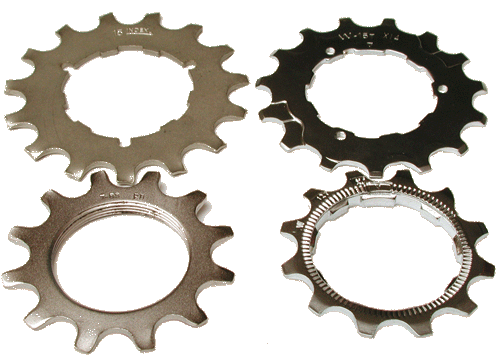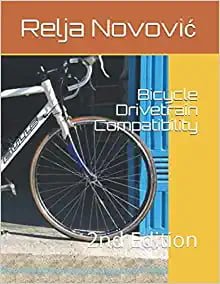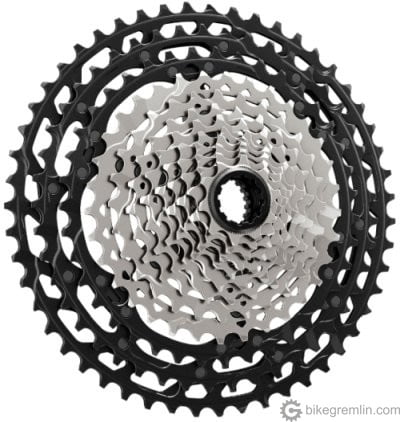This article will explain bicycle cassette compatibility i.e. what cassettes can be mixed with which rear shifters/derailleurs. For compatibility with various chains, see the chain compatibility article. Overview of compatibility and possible combinations will be given according to the number of sprockets. From the old 6 sprocket standard to the newest 12 sprocket one. There are two things to consider when combining cassettes: number of sprockets, and sprocket spacing. Both those things affect the cassette width and indexing of shifters. Table with sprocket thickness and spacing is at the end of this post.
Before you start, to avoid any misunderstanding:
please take the 5 minutes needed to read the compatibility articles use instructions.
Related article: Speeds – rear sprockets.
Indexed shifters work with clicks – each click changes one “speed”. In order to function properly, they require that derailleur movement ratio and sprocket widths are matched with shifter’s cable pull ratio. This is explained in detail in a separate article on shifters: Rear shifter compatibility.
One more thing before explaining compatibility: there are two main standards of cassette mounting. Freewheel and freehub. That is explained in the article: Freewheel vs cassette. 6 speed is always with a freewheel. 8 and more speeds is always a freehub cassette (there used to be 8 speed freewheels, but those where never widespread and are now obsolete). 7 speeds usually come as freewheel cassettes, but can also be found in a freehub cassette standard.
Most manufacturers’ cassettes (and freehub body splines) are compatible with Shimano (SRAM, Sun Race etc.), while Campagnolo cassettes use different freehub splines – that is explained on. Also, SRAM XD cassettes (and freehub body splines) differ from all the rest. All this is explained in Rear hub compatibility post. These mounting standards are important for physical mounting of the cassette on the wheel, they have nothing to do with chain and shifter/derailleur compatibility.
6 speeds
All the 6 speed sprockets are with a freewheel. As a rule of thumb, all the models of all the manufacturers can be interchanged without problems. Shimano’s standard is widely accepted, though you might come accross an “exotic” model with narrower sprockets, more narrowly packed.
Sprockets are placed at 5 to 5.5 mm spacing, with each sprocket being 1.85 to 2 mm thick (depending on the model).
7 speeds freewheel
Sprocket width and spacing is the same as for some 6 speed systems. Here, Shimano standard is widely accepted and all the manufacturers’ 7 speed freewheels are compatible with it.
Sprockets are placed at 5 mm spacing, with each sprocket being 1.85 mm thick.
7 speed freehub (cassette)
There is an obsolete Shimano Uniglide standard, and a current, Shimano Hyperglide standard. If for any reason you have a Shimano Uniglide cassette, they can be fitted onto a Hyperglide freehub, just the smallest sprocket needs to be replaced with a Hyperglide one.
Uniglide uses threaded smallest sprocket to hold the cassette in place, while the Hyperglide uses a special lockring.

To the right are two Hyperglide sprockets (bottom smallest, top 2nd smallest)
Front part of the smallest Hyperglide sprocket has small teeth to hold the lockring in place.
All the modern cassettes are of Hyperglide standard, regardless of the teeth number. In case of having a uniglide freehub, mounting a modern (available) hyperglide cassette can be done in two solutions. One is to remove smallest sprocket off the (new) hyperglide cassette and use the (worn) smallest uniglide sprocket as a lockring, filing/grinding off the widest spline of the rest of the (new) hyperglide sprockets. More complicated (probably better) solution is to switch the freehub body for a hyperglide one. Video explaining it is here: converting an uniglide freehub to a hyperglide.
This goes for 8 speed as well: 7 speed cassettes have the same sprocket width as 6 and 8 speeds, but 8 speed is a bit tighter spaced – at 4.8 mm. This means that 8 speed sprockets can be used for 7 speed cassettes, as long as the 7 speed spacers between sprockets are used.
Many cassettes have sprockets held together with 3 small rivets, but these are only for convenience when mounting and can be removed so that sprockets can be swapped.
8 speeds
The same sprocket width as with 6 and 7 speeds, but a bit tighter spaced – at 4.8 mm. This means that 7 speed sprockets can be used for 8 speed cassettes, as long as the 8 speed spacers between sprockets are used.
Sprockets are placed at 4.8 mm spacing, with each sprocket being 1.85 mm thick.
Campagnolo 8 speed cassettes have just slightly different sprocket thickness and spacing, compared to Shimano, so they can be mixed with Shimano 8 speed shifters and derailleurs, with index shifting working good. Provided that appropriate freehub body is used: Campagnolo and Shimano cassettes can’t fit each other’s freehubs – Campy with Campy, Shimano with Shimano.
Note:
As noted in the 2nd post in this bikeforums compatibility thread, “good” depends on your criteria. It won’t be perfect (table 1 lists sprocket spacing and spacer thickness and shows the difference between Campagnolo and Shimano 8-speed cassettes – Campagnolo 8-speed sprockets are spaced as Shimano 7-speed ones, but are slightly narrower, with thicker spacers between them).
9 speeds
Here there is no combining with any other standard. 9 speed cassettes have a unique sprocket thickness and spacing. Campagnolo has their own 9 speed standard, incompatible with Shimano’s.
Sprockets are placed at 4.35 mm spacing, with each sprocket being 1.78 mm thick.
10 speeds
Same sprocket width as 11 speeds, so (more expensive) 11 speed sprockets can be used as replacement, provided 10 speed spacers are used.
See this catch about the modern Shimano 10-speed cassettes (keeping that info in one place for easier updating).
Sprockets are placed at 3.95 mm spacing, with each sprocket being 1.6 mm thick.
This doesn’t go for Campagnolo. Campy 10 speed is only compatible with Campy 10 speed because of different mounting, so an individual Shimano compatible sprocket can’t be mounted.
11 speeds
Sprocket width is the same as for 10 speeds, so 10 speed sprockets can be used, provided that 11 speed spacers are used.
Sprockets are 1.6 mm thick, spaced at 3.74 mm (road), or 3.9 mm (MTB).
For more clarity on this, see below the comment by Nicolas Hanssens and the following four replies by myself and Nicolas Hanssens. I.e, based on my last measurement, and practical experience, Shimano MTB and road 11-speed cassettes have very slight differences that don’t make a noticeable difference when it comes to shifting (video explaining an 11-speed MTB cassette on a road bike pairing).
Campagnolo of course doesn’t accept any 10 speed sprockets. However, just like with 8 speeds, combining complete cassettes is possible: Campagnolo 11 speed cassettes have just slightly different sprocket thickness and spacing, compared to Shimano, so they can be mixed with Shimano 11 speed shifters and derailleurs (and vice versa), with index shifting working good. Provided that appropriate freehub body is used: Campagnolo and Shimano cassettes can’t fit each other’s freehubs – Campy with Campy, Shimano with Shimano.
With 11 speeds there is another exception: it is the only case where Shimano standards for road and MTB differ. For all the other standards, MTB and road cassette is just a marketing term, explaining the number of teeth bigger sprockets have and the difference in sprocket teeth numbers between adjacent sprockets, but with 11 speeds, cassettes really differ. 11 speed road has a longer freehub body, while MTB 11 speed cassette fits 8-9-10 speed freehub. However, sprockets, except the largest one, can be mixed and matched.
Also, SRAM makes XD 11 speed MTB cassettes that fit only SRAM XD freehubs, they can’t be mounted onto other freehub types. These cassettes can accommodate a small sprocket with only 10 teeth.
Update of summer 2018: Shimano introduced new Hyperglide+ cassette standard. These come as 11 and 12 speed cassettes. They require a special freehub body (with different spline design called “Micro Spline“), as well as a special Hyperglide+ chain. The same chain is used for both 11 and 12 speeds, but works only with Hyperglide+ cassettes. Also, derailleurs and shifters of other standards won’t work. Smallest sprocket has 10 teeth.
12 speeds
These come in four different standards.
- First one is SRAM MTB XD. These are compatible with SRAM XD 11 speed freehubs. Smallest sprocket has 10 teeth.
- As of mid-2018, SRAM has introduced NX Eagle groupset, that includes 12 speed cassettes compatible with Shimano (and SRAM) standard freehubs (for 8, 9, or 10 speed cassettes). However, they don’t allow for the smallest sprocket to be smaller than 11 teeth.Sprockets are spaced at 3.65 mm, with the smallest two placed slightly more apart to accommodate for crossed chain when using a crankset with only one chainring.
- Shimano Hyperglide+ 12 speed MTB cassettes, compatible only with Hyperglide+ chains and Hyperglide+ freehubs (using Micro Spline mounting system). Smallest sprocket has 10 teeth.
- In 2018, Campagnolo also jumped on the “more-speeds” bandwagon, introducing their 12 speed groupsets. Campagnolo 12 speed cassettes fit their (Campagnolo) 11 speed freehubs.
One exception: Shimano Dura Ace from year 1984 to 1996 (6 to 8 speeds)
Compatible only with Shimano Dura Ace shifters and RDs from the same period (6, 7 and 8 speeds), because of a different cog pitch.
Correction: cassettes are the same, what differs is the amount of derailleur movement per 1mm of cable pull/release. For a bit more details on this, see my rear shifter article’s section 5.1: “Shimano Dura Ace from 1984 to 1996 (6 to 8 speeds).”
Campagnolo Exa-Drive and Ultra-Drive

Left: Exa-Drive
Right: Ultra-Drive
Stamped circle is just an indicator helping proper alignment when mounting sprockets. No mechanical function whatsoever.
Indented grooves are used to pick the chain up when shifting to a larger sprocket. Exa-Drive indentations are designed to catch the chain pin first, then the outer plate. They work well with 8 and 9 speed Campagnolo chains.
Modern 10 and 11 speed Campagnolo chains don’t have pins protruding out of outer plates, so the newer Ultra-Drive is designed to catch the outer plates directly.
Sprockets of these two standards (with equal number of speeds) can be combined, although it will affect gear changing speed. 🙂
Table overview (sprocket and spacer thickness)
Table of sprocket spacing and thickness:
For a full chart including spacer thickness, total cassette width, freehub mount standards etc, see – bicycle cassette standards post.
– It is easier to keep the tables up-to-date when they are posted in one place only.
| Cassette | Cassette pitch | Sprocket thickness |
| mm. | mm. | |
| All 6-speed | 5 – 5.5 | 1.85 – 2 |
| All 7-speed | 5 | 1.85 |
| Shimano 8-speed | 4.8 | 1.8 |
| Shimano 9-speed | 4.35 | 1.78 |
| Shimano 10-speed | 3.95 | 1.6 |
| Shimano 11-speed road * | 3.74 * | 1.6 |
| Shimano 11-speed mtb * | 3.9 * | 1.6 |
| Campagnolo 8-speed | 5 | 1.9 |
| Campagnolo 9-speed | 4.55 | 1.75 |
| Campagnolo 10-speed | 4.15 | 1.7 |
| Campagnolo 11-speed | 3.85 | 1.6 |
| SRAM 8-speed | 4.8 | 1.8 |
| SRAM 9-speed | 4.35 | 1.8 |
| SRAM 10-speed | 3.95 | 1.6 |
| SRAM 11-speed road | 3.74 | 1.6 |
| SRAM 11-speed mtb | 3.9 | 1.6 |
| SRAM 12-speed mtb | 3.65 | n/a |
| Shimano Dura Ace 6 speeds | 6.07 | n/a |
| Shimano Dura Ace 7 speeds | 5.52 | n/a |
| Shimano Dura Ace 8 speeds | 5.3 | n/a |
* See the explanation in chapter 11.
Last updated:
Originally published:
Compatibility posts are also available in eBook (printable and Kindle) and paperback editions on Amazon:

The existing comments posted under this article (questions and answers) have been moved to this BikeGremlin forum thread:
https://www.bikegremlin.net/threads/compatibility-02-cassettes-article-comments.104/


Re: 11s MTB pitch…
For the record, one should keep in mind that those black aluminium sprockets on 11-speed MTB cassettes are thicker than the steel ones (about 2 mm vs 1.6 mm). That could throw off the calculations a bit.
I have a cyclo cross bike with an 11 speed SRAM PG-1170, 11-36, road cassette paired with a SRAM force rear mech. I’ve been wanting to fit a pair of wheels on this bike from a 29er mtb with DT Swiss 240 MTB Hubs with a 10/11 speed freehub body fitted. I hadn’t appreciate all the complexity with 10/11 speed compatibility between road and MTB and found this blog and the comments really useful.
I didn’t want a huge 11 speed MTB cassette with a 50 sprocket (all the Shimano and SRAM 11 speed MTB cassettes all seem to have a 48 or 50 sprocket) as that isn’t ideal for cyclocross or gravel and a Shimano or SRAM 11 speed road cassette won’t fit the freehub as these cassettes are too wide.
My solution has been to use a Sunrace CSMS8 cassette. These are 11 speed MTB cassettes and for the mtb 10/11 freehub but you can get an 11-36 which is much better for the cyclo-cross/gravel bike.
In terms of spacing of sprockets I have compared the SRAM road cassette and the Sunrace MTB cassette and I can’t tell any difference in width, although it’s quite hard to measure precisely. Visually, all the sprockets line up. Gears run smoothly, even under load
Hopefully others will find this useful
Duncan